Emergency GO BAG
Prepare yourself for natural disasters!

The GO BAG (or bugout bag), once thought of as a security blanket for the conspiracy theorist, has gained the status of a legit safety item that you need in your home.
In fact, government and city officials recommend having a GO BAG ready at all times.
The idea behind the go bag is simple. If an emergency happens, you grab your GO BAG and... go. It contains items that help you survive until you can return home. Here's everything you need to know.
Why you need a GO BAG
Think you needn't bother? Hurricane preparedness isn't the only reason you need a GO BAG. You may need to flee your home to find new shelter at a moment's notice because of:
- Earthquakes
- Tornadoes or hurricanes
- Flash floods
- Wildfires
- Mudslides
- Ice storms
- Zombie apocalypse
What kind of GO BAG is best?
The city of Chicago, no stranger to strong winds, recommends that each member of your household have their own GO BAG. If you're the parent of small children, however, you can use one big GO BAG to hold everything you and your children need.
Remember, the best kind of bag is the kind you can carry. Don't get a huge duffle bag unless you're very strong and can heft it. Also, you want a bag that will fit easily in your car. You don't want one that's so big you'll have to leave one of the kids behind to take it with you.
A hiking backpack with various pockets is your best bet. Make sure it's made from a strong canvas material and has a strap that secures around your chest. This will take some of the strain off your back if you need to walk a long way.
Also, look for a pack that has a water reservoir you can fill with drinking water. These are often called camelbacks.
Water is important, but make it, don't carry it
Though many experts recommend having a three-day supply of water in your home in case of an emergency, running with that amount of water can be impractical, especially if you don't have a car. The alternative is keeping a device in your go bag that can turn water from ditches, streams, ponds and other water sources into clean drinking water.
Be warned, though. Many emergency filtration devices like these need to be prepped with drinking water before they can be used as a filter for yucky water. Be sure to read the directions and prep your bottle before clipping it to your go bag.
Get GOOD LIGHTING that lasts
In an emergency, batteries may be in short supply, especially in a hurricane. That's why it's a good idea to put a lighting system in your GO BAG that can be powered by a renewable resource.
Here is what we recommend:
Fenix LR35R PRO - 10,000 lumens
Super Bright Palm-Sized Searching Flashlight

The Fenix LR35R Pro is a super bright flashlight built for exceptional performance and versatility. It delivers an impressive 500-meter beam distance with a blinding 10,000-lumen output. Additionally,... To learn more about this product, please click here >>>
Fenix LR35R - 10,000 lumens
Super Bright Rechargeable Flashlight

The Fenix LR35R is a super bright searching flashlight that blasts a max output of 10000 lumens and a max beam distance of 500 meters. This 10000 lumens flashlight can be quickly charged with the two ... To learn more about this product, please click here >>>
Fenix TK20R V2.0 - 3,000 lumens
Rechargeable Dual Rear-Switch Multipurpose Flashlight

The Fenix TK20R V2.0 is a multipurpose tactical flashlight featuring an incredible performance by throwing a maximum of 3000 lumens and a beam distance of up to 475 meters. Quickly and easily operate ... To learn more about this product, please click here >>>
Fenix PD35R ACE - 2,000 lumens
Multi-Mode Tactical Flashlight

The Fenix PD35R ACE delivers powerful and reliable illumination with a maximum output of up to 2000 lumens and a maximum beam distance of 380 meters. Its innovative SET mode design provides three ligh... To learn more about this product, please click here >>>
Fenix PD35 V3.0 - 1,700 lumens
High-Performance Tactical Flashlight

The improved PD35 V3.0 flashlight is destined to enrich the PD35 series flashlights. This light delivers a maximum of 1700 lumens at a distance of 357 meters. This Fenix PD35 V3.0 is compact but tough... To learn more about this product, please click here >>>
Fenix LD30R - 1,700 lumens
High-Performance Outdoor Flashlight

The Fenix LD30R is the perfect lightweight and high-performance outdoor flashlight. Operating on an included 3400mAh rechargeable battery, the flashlight emits a maximum output of 1700 lumens at a dis... To learn more about this product, please click here >>>
Fenix E28R V2.0 - 1,700 lumens
Rechargeable EDC Flashlight

The Fenix E28R V2.0 is a rechargeable EDC flashlight that is long-awaited by EDC lovers. Powered by an included 3400mAh battery, this flashlight boosts a max output of 1700 lumens and a max beam dista... To learn more about this product, please click here >>>
Fenix E-CP - 1,600 lumens
High-Performance Powerbank Flashlight
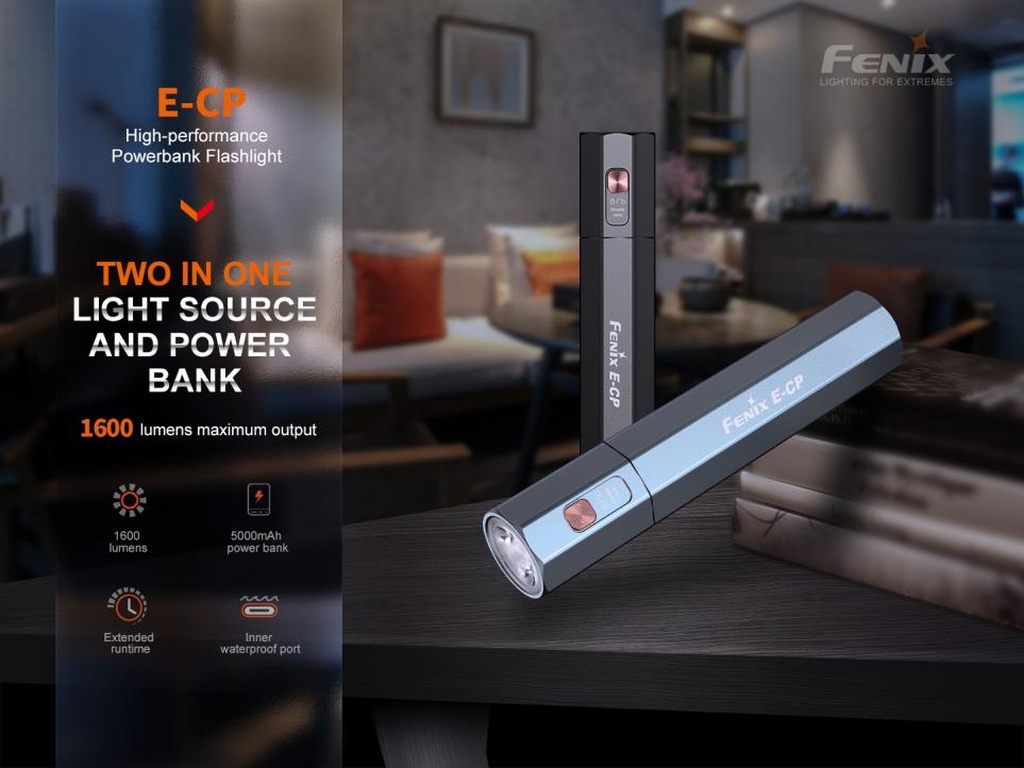
The Fenix E-CP is a high-output flashlight with a power bank that's capable of projecting 1,600 lumens with a useful far-reaching beam of 222 meters. The built-in 5000mAh high-capacity battery can las... To learn more about this product, please click here >>>
Fenix HM71R - 2,700 lumens
High-Performance Rechargeable Industrial Headlamp

The Fenix HM71R is a high-performance rechargeable headlamp for industrial lighting scenarios which includes a magnetic base and belt clip for continued hands-free use. Combined spotlight and floodlig... To learn more about this product, please click here >>>
Fenix HM71R with extra ARB-L21-5000 V2.0 battery - 2,700 lumens
High-Performance Rechargeable Industrial Headlamp
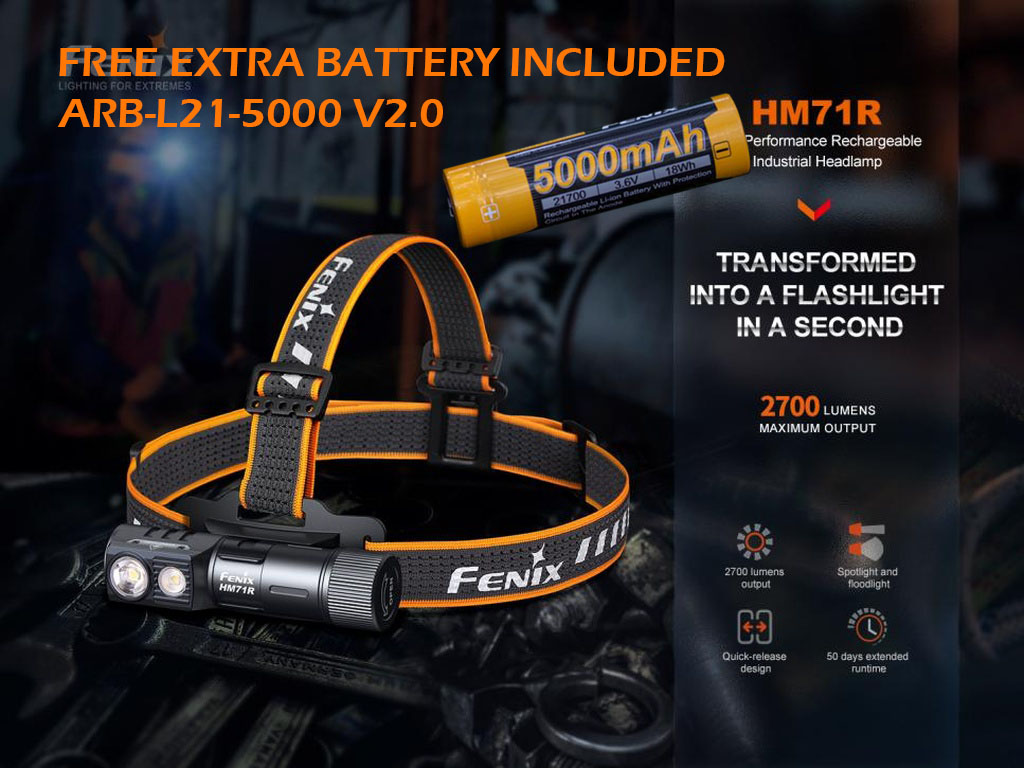
The Fenix HM71R is a high-performance rechargeable headlamp for industrial lighting scenarios which includes a magnetic base and belt clip for continued hands-free use. Combined spotlight and floodlig... To learn more about this product, please click here >>>
Fenix HM61R V2.0 - 1,600 lumens
Multifunctional Rechargeable Headlamp

THE HM61R V2.0 is a highly reliable rechargeable headlight, which can be easily switched between headlight, flashlight and chest light. The brightness is as high as 1600 lumens, the red and white ligh... To learn more about this product, please click here >>>
Fenix HM60R V2.0 - 1,600 lumens
Outdoor High-Performance Metal Headlamp
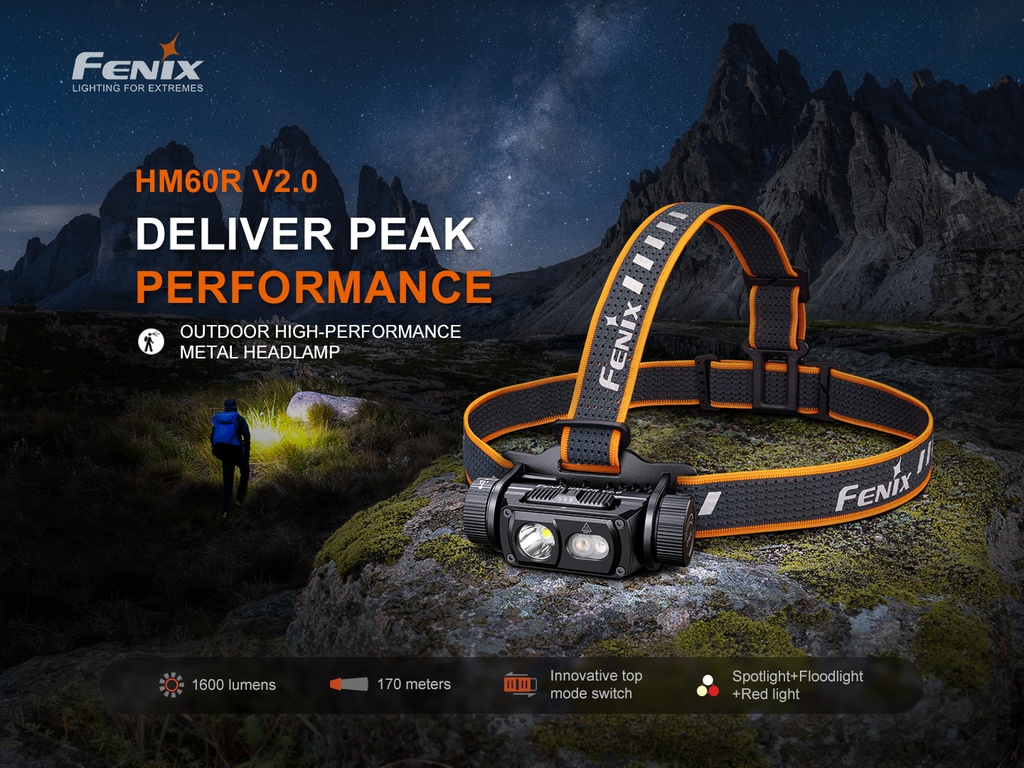
The Fenix HM60R V2.0 is a high-performance metal headlamp that combines a spotlight, a floodlight, and a red light. It delivers a maximum output of 1600 lumens and a maximum beam distance of up to 170... To learn more about this product, please click here >>>
Fenix HM65R - 1,400 lumens
Dual Light Rechargeable Headlamp

The Fenix HM65R Rechargeable headlamp is designed to endure all the elements. This new Fenix headlamp is constructed from ultra lightweight magnesium material. With two Cree LED's, the HM65R can reach... To learn more about this product, please click here >>>
Fenix HM50R V2.0 - 700 lumens
Rechargeable Multipurpose Headlamp
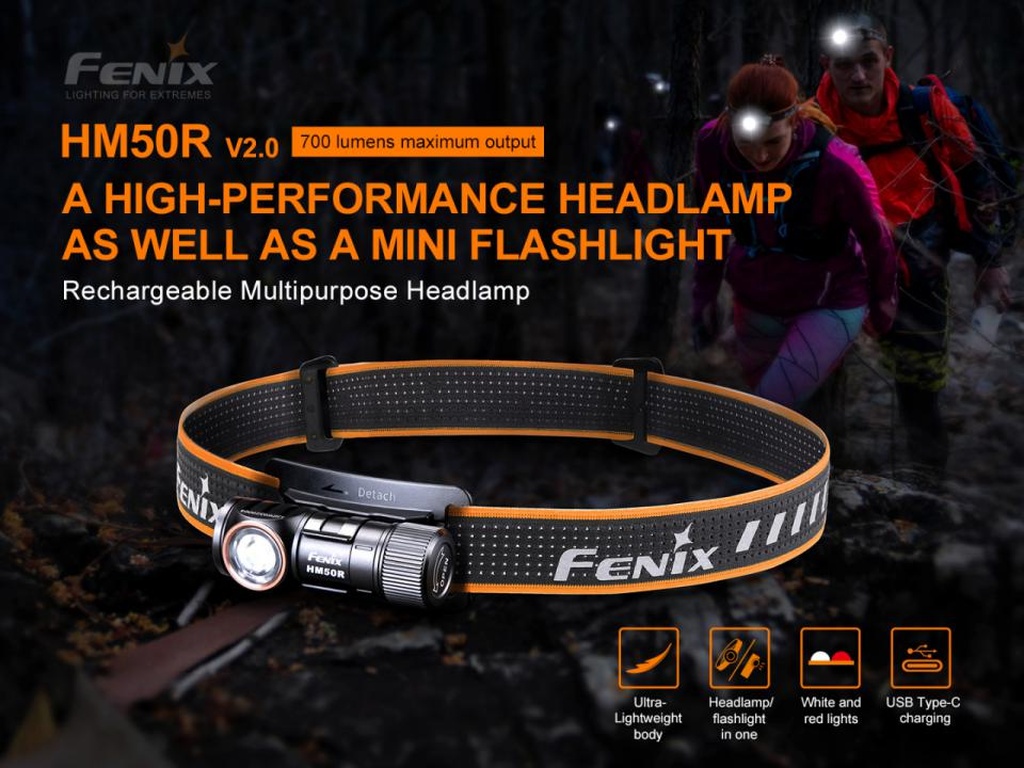
The Fenix HM50R V2.0 is a rechargeable multipurpose headlamp. One 16340 rechargeable Li-ion battery is included to power it. This headlamp is power-packed throwing a 700 lumens beam to a maximum dista... To learn more about this product, please click here >>>
Fenix CP50R - 5,500 lumens
Multifunctional Vehicle Camping Lantern
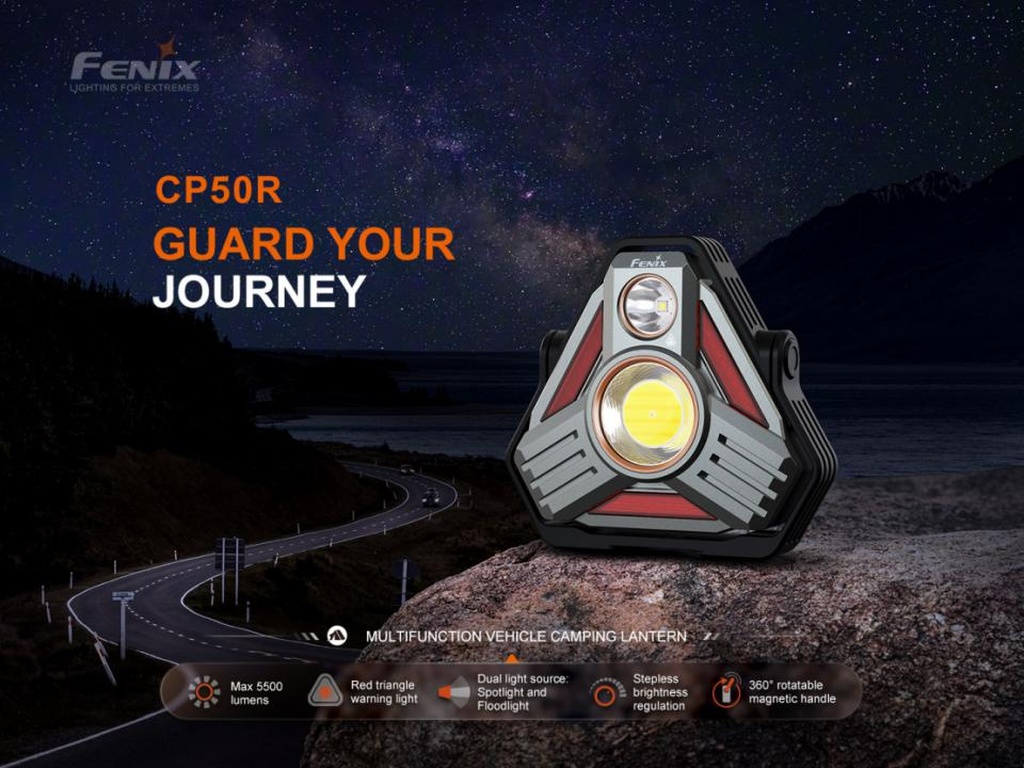
The Fenix CP50R lantern is an exceptional vehicle camping lantern with a powerful output of 5500 lumens and a beam distance of 450 meters. This versatile lantern features a dual distance beam system, ... To learn more about this product, please click here >>>
Fenix CL28R - 2,000 lumens
Rechargeable Lantern With Color Adjust
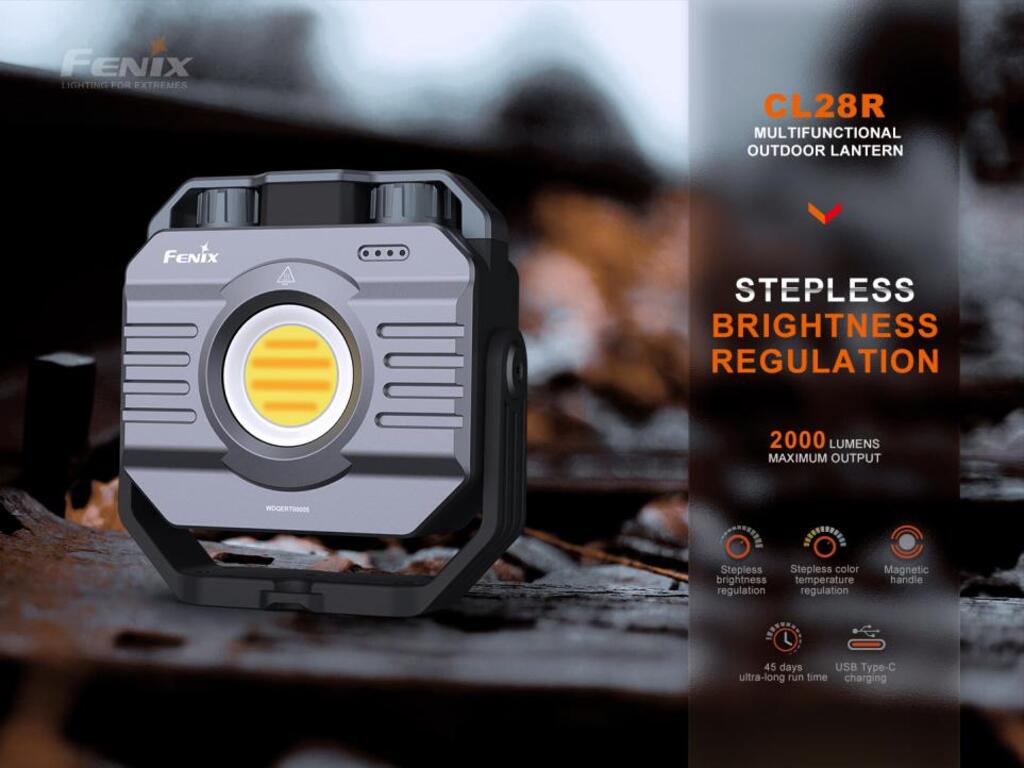
The Fenix CL28R Lantern is a great option to light up you campsite or worksite. A 2000 max lumen white light output, allows you to light up a 160° area up to 190 feet away. The most unique feature of ... To learn more about this product, please click here >>>
Fenix CL27R - 1,600 lumens
Spot-And-Floodlight Multifunctional Outdoor Lantern

The Fenix CL27R is a versatile and reliable outdoor lantern that can be used for various applications, from camping to industrial operations. It boasts a combined maximum brightness of 1600 lumens and... To learn more about this product, please click here >>>
Fenix CL30R - 650 lumens
Rechargeable Camping Lantern

The Fenix CL30R rechargeable camping lantern offers flexibility in power, charging and brightness levels. This versatile lantern not only features a Micro USB port to recharging, but it is the first F... To learn more about this product, please click here >>>
Fenix CL26R Pro - 650 lumens
Rechargeable Lantern

The Fenix CL26R Pro is a multifunctional rechargeable camping lantern. This compact and portable lantern is extremely powerful with 650 lumens of maximum output and a long runtime of 408 hours. Fenix ... To learn more about this product, please click here >>>
Fenix CL22R - 500 lumens
Outdoor Multicolored Camping Lantern

Fenix CL22R is a compact portable camping lantern that will elevate your camping experience to the next level. Powered by a built-in2600mAh battery, you can charge the lantern via the USB Type-C charg... To learn more about this product, please click here >>>
Other essentials
Water and light should be at the top of your list, but there are plenty of other things you should toss in your bag:
- Nonperishable food. Meals ready to eat (MREs) are a popular choice, but freeze-dried items work, too. Just be sure they're light, provide a lot of calories and protein, and have a shelf life of months, if not years.
- A good multi-tool that includes a knife, pliers, a can opener and other tools.
- Paracord, also called 550 cord, can hold up to 550 pounds and is compact, so choose it instead of regular rope.
- Carabiners: These metal loops with a spring-loaded latch have a million and one uses, like latching gear to the outside of your go bag.
- A whistle to signal others if you need help and can't yell.
- A poncho and a change of clothes.
- Your family's prescription medications for a week and copies of your prescriptions. You'll probably want to toss these in the go bag as you leave, since keeping extras in your bag will be impractical for most people.
- A small first aid kit with bandages, antiseptic, pain killers and gauze.
- Personal care items such as soap, a toothbrush, toothpaste, toilet paper, feminine hygiene products and so on. Put these items in waterproof baggies.
- Your extra house and car keys.
- A warm blanket. Put it in a plastic bag, use the hose on your vacuum to suck the air out of the bag and quickly seal it to save room.
- A recent family photo for identification purposes, also in a plastic bag, to keep it safe from moisture.
- Cash in small denominations and coins.
- A regional map so you can find your way without a phone when cell towers and GPS are down or busy, or you've run out of battery.
- Paper, pens and tape to leave messages for others.
- A dust mask.
- Copies of important documents such as insurance information, IDs, proof of address and passports, all in a waterproof plastic bag.
- Your family photos and document copies on a USB drive. This one is optional, but I like the security of knowing I have some of my family's precious memories with me.
- Pet supplies such as a leash, collapsible water bowl and food.
